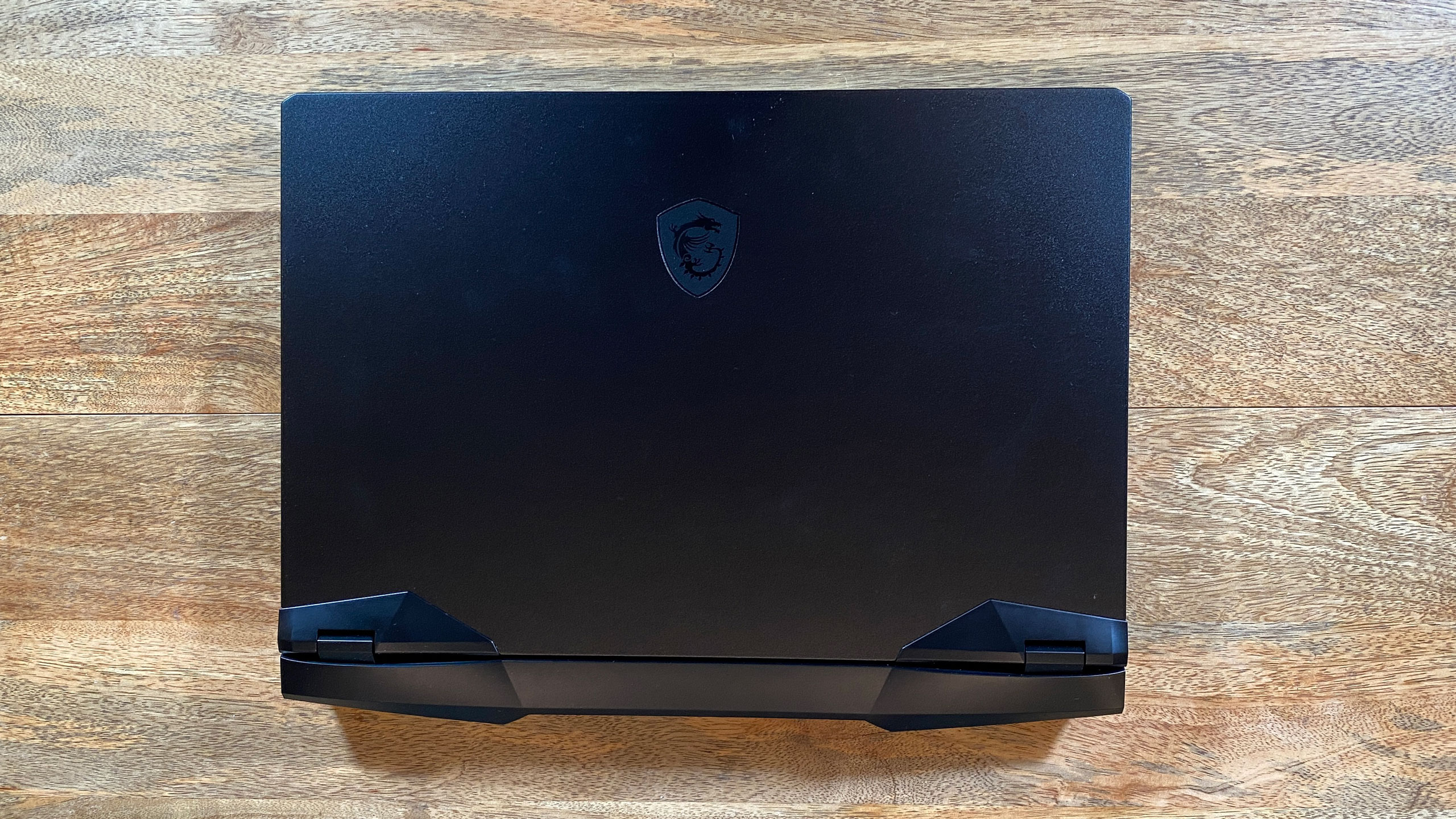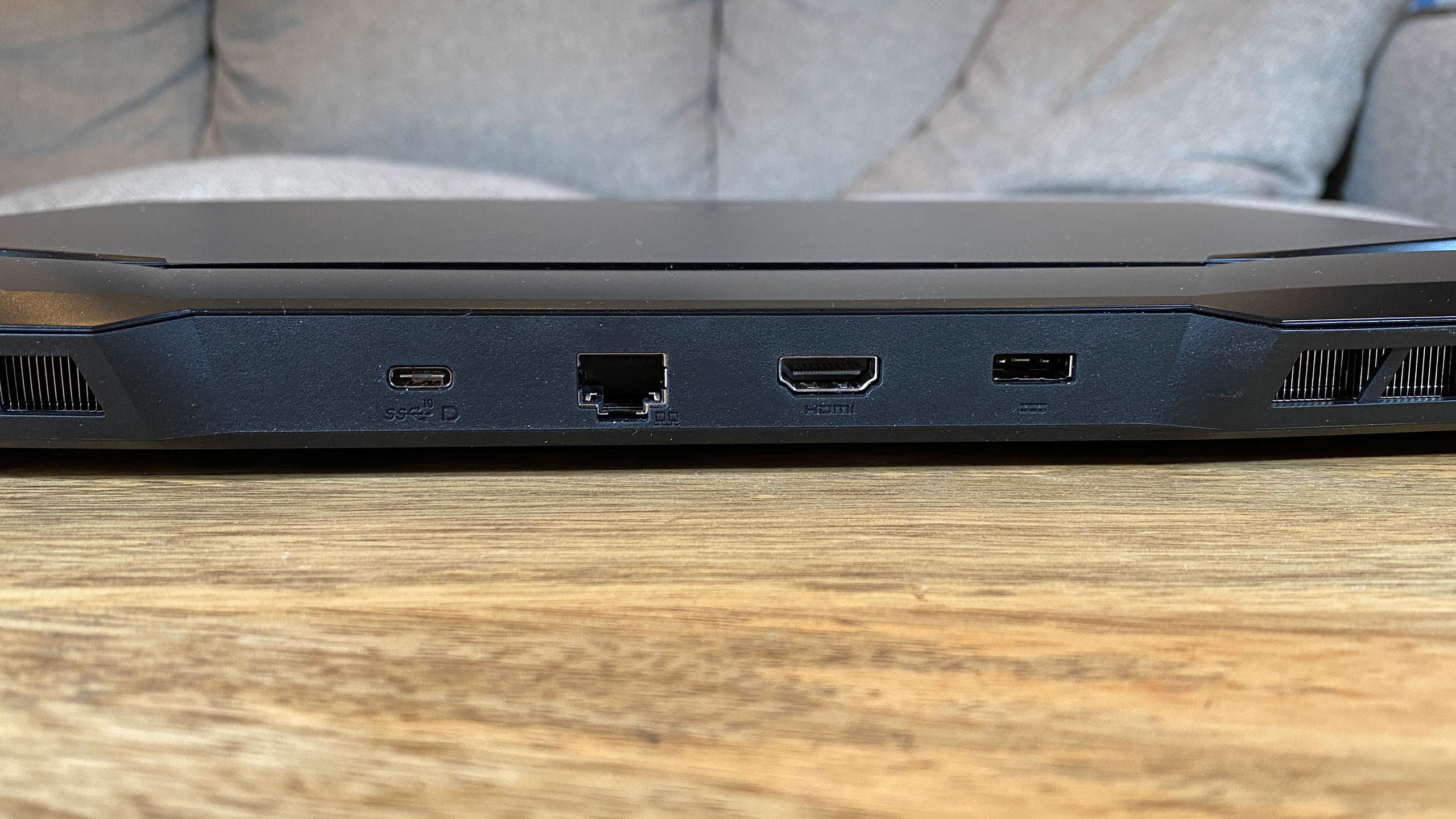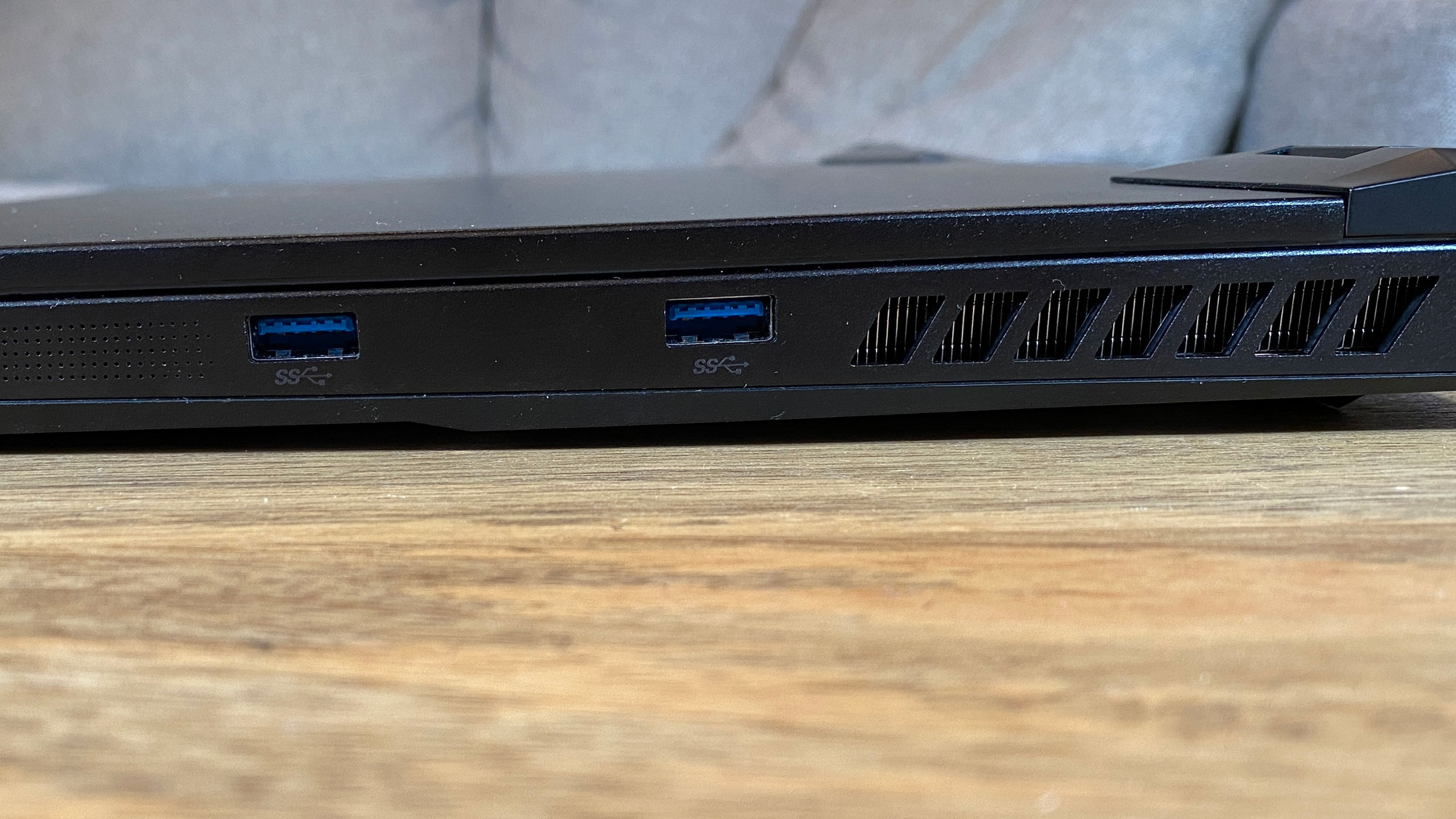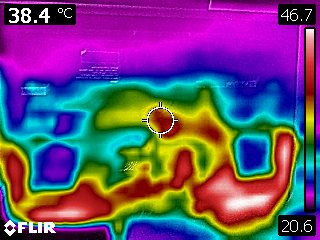Tom's Hardware Verdict
The MSI GP66 Leopard is a powerhouse gaming notebook housed in a fairly subtle shell that also boasts a comfortable keyboard. It also offers plenty to upgrade or repair, but it's a chore getting inside.
Pros
- +
Strong gaming performance
- +
Comfortable keyboard
- +
Replaceable components
- +
Subtle design for a gaming notebook
Cons
- -
Difficult to open
- -
Touchpad feels cheap
- -
Too much bloatware
Why you can trust Tom's Hardware
Just because you grow up a bit doesn't mean you need to stop having fun. The MSI GP66 Leopard ($1,799.00 to start, $2,599.00 as tested) is a powerhouse gaming notebook with an Nvidia GeForce RTX 3080 and Intel Core i7-10870H. But it would fit in anywhere, whether it be an office or a gaming room, thanks to its matte-black stylings. If you're looking for gaming power without all of the flash, this might be on your list of the best gaming laptops.
If you ran some workstation tasks on this, you might believe it was a work machine. Only when you turn on the RGB keyboard do you know it's time to play. There aren't red stripes, or, say, an RGB lightbar like MSI's other models.
It's a powerhouse, and many of the components are upgradeable for replacement down the line. But while the GP66 Leopard is all grown up, there are still some areas, like its touchpad and its bloatware, where it needs some more maturing.
Design of the MSI GP66 Leopard


As far as MSI's gaming notebooks go, the Leopard is quite plain. While some of its other laptops have red accents or RGB light strips, the GP66 is an all-black affair. On the aluminum lid, even the dragon shield logo is tone-on-tone. Only the hinges, which are connected to aggressively shaped plastic molds, suggest this is anything other than a workstation PC.
The only real sign of the GP66's gaming prowess is the keyboard, which has RGB backlighting courtesy of SteelSeries. But the black aluminum deck and the fairly thin bezels around three sides of the display suggest just a premium notebook. The bottom cover is plastic.



The Leopard is a thick machine at 0.92 inches tall, so there's plenty of room for ports. However, MSI has placed only a few of them on the sides: The right side has a pair of USB 3.2 Gen 1 Type-A ports, while the left side has another Type-A and the headphone jack. The rest of the ports — USB 3.1 Gen 2 Type-C, HDMI, RJ-45 Ethernet and the charging port — are all on the rear of the device. Alienware has been doing this for years, and it's a benefit if you use your laptop like a desktop replacement and don't move it around much. But it can also be inconvenient if you like to use your laptop on your lap.
At 14.09 x 10.51 x 0.92 inches and 5.25 pounds, the Leopard isn't exactly portable in the toss-it-in-a-bag sense. Dell's 15-inch competitor, the Alienware 15 m4, is slightly lighter at 5 pounds and a similar size 14.2 x 10.9 x 0.9 inches, but its design is slightly more sleek. The Gigabyte Aorus 17G is expectedly larger with a bigger screen, at 5.95 pounds and 14.9 x 10.8 x 1 inches.
MSI GP66 Leopard Specifications
| CPU | Intel Core i7-10870H |
| Graphics | Nvidia GeForce RTX 3080 Laptop GPU (8GB GDDR6, 130W Max graphics power, 1605MHz boost clock) |
| Memory | 32GB DDR4-3200 |
| Storage | 1TB M.2 NVMe PCIe 3.0 SSD |
| Display | 15.6, 1920 x 1080, 240 Hz |
| Networking | Intel Wi-Fi 6 AX201 (2x2 ax), Bluetooth 5.1 |
| Ports | 3x USB 3.2 Gen 1 Type-A, USB 3.2 Gen 2 Type-C, HDMI, 3.5 mm headphone jack, RJ-45 Ethernet |
| Camera | 720p |
| Battery | 65 Wh |
| Power Adapter | 230W |
| Operating System | Windows 10 Home |
| Dimensions(WxDxH) | 14.09 x 10.51 x 0.92 inches / 357.89 x 266.95 x 23.37 mm |
| Weight | 5.25 pounds / 2.38 kilograms |
| Price (as configured) | $2,599.00 |
Gaming and Graphics on the MSI GP66 Leopard
MSI opted for a powerful implementation of the Nvidia GeForce RTX 3080 for the GP66 Leopard. This version has a 130W max graphics power and a boost clock of 1,605 MHz.
Besides running benchmarks, I tried playing Control, a game I use often on laptops with RTX GPUs because of how tough it is to run and because ray tracing has a truly noticeable effect. With the settings maxed out at 1080p and with ray tracing on high, the game ran between 52 and 57 frames per second as I traded shots with hiss guards surrounding a control point, though it went as high as 70 during exploration.





On Shadow of the Tomb Raider (1080p, highest), the GP66 hit 106 frames per second. The Aorus 17G, with an RTX 3080 Max-Q ran the game at 86 fps, while the Alienware m15 R4 with an RTX 3070 played it at 77 fps.
The Leopard played Grand Theft Auto V (1080p, very high) at 125 fps, beating the Aorus (100 fps) and Alienware m15 (108 fps).
MSI's laptop ran Far Cry New Dawn (1080p, ultra) at 103 fps, beating both the Alienware and Aorus by over 10 frames per second.
Get Tom's Hardware's best news and in-depth reviews, straight to your inbox.
The GP66 Leopard outperformed on Red Dead Redemption 2 (1080p, medium), playing at 82 fps.
It also won out on Borderlands 3 (badass, 1080p), at 99 fps, while the Aorus 17G ran at 79 fps and the Alienware hit 84 fps.
We also ran our gaming stress test on the GP66 Leopard by looping the Metro Exodus benchmark at RTX settings for 15 runs, simulating roughly half an hour of gaming. It ran at a largely steady average of 76.38 frames per second across the runs. The CPU ran at an average of 3.73 GHz and an average temperature of 61.85 degrees Celsius (143.3 degrees Fahrenheit). The GPU ran at an average of 1.1 GHz and 61.49 degrees Celsius (142.68 degrees Fahrenheit).
Productivity Performance on the MSI GP66 Leopard
Beyond gaming, the GP66's Intel Core i7-1070H and GeForce RTX 3080, along with 32GB of RAM and a 1TB SSD are powerful parts that should aid in creative endeavors like streaming or video editing.



On the Geekbench 5 overall performance benchmark, the GP66 earned a single-core score of 1,274 and multi-core score of 7,848. The Gigabyte Aorus 17G had scores of 1,265 and 7,895, respectively, while the Alienware 15 R5 notched scores of 1,252 and 7,642.
On our file transfer test, the Leopard copied and transferred 25GB of files at a rate of 1,059.78 MBps, falling just below the Alienware but ahead of the Aorus.
It took the GP66 Leopard seven minutes and three seconds (7:03) to complete our Handbrake test, transcoding a 4K video to 1080p. That's slightly faster than the Alienawre (7:07) and far speeder than the Aorus (8:33).
Display on the MSI GP66 Leopard
Our review unit came equipped with a 15.6-inch, 1920 x 1080 (FHD) display with a 240 Hz refresh rate. The most demanding titles won't run that fast, but you can take advantage of it if you like playing esports titles like Overwatch, Fortnite or Rocket League.
When I watched the trailer for the upcoming Mortal Kombat movie, I felt the need to turn up the brightness for the best experience. Cole's yellow gloves popped, as did Kano's red eye lasers against a dark background, but the screen was largely serviceable rather than special.
When I played Control, the screen was bright enough, even in some dark spaces. That game has a lot of red, and it really popped, especially against the Oldest House's dark walls.
MSI's panel covers 78.5% of the DCI-P3 color gamut, matching what we saw on the Aorus 17G. We reviewed the Alienware m15 R4 with a 4K OLED screen, so it's not surprising to see superior coverage there.
However, at 277 nits of brightness, the screen was dimmer than both the Aorus (300 nits) and the Alienware (362 nits).
Keyboard and Touchpad on the MSI GP66 Leopard
MSI's inputs are a mixed bag. Arguably the more important part of a gaming laptop, the keyboard, is the superior of the two. For years now, MSI has partnered with SteelSeries on its keyboards, and they've typically been quite good. On the Leopard, the keys are a bit more shallow than I would like, but they're still fairly comfortable to type on. I hit 120 words per minute with a 2 percent error rate, which is about as fast as I ever get on the 10fastfingers.com typing test.
The 2.5 x 4.1-inch touchpad is fine for navigating and gestures with its Windows precision drivers, but it felt like cheap plastic compared to the aluminum around it. On top of that, I found I had to click harder than on most laptops. For gaming, you should be using a mouse anyway, but this could be a little better for general productivity use.
Audio on the MSI GP66 Leopard


When I listened to Daft Punk's "Something About Us," the various synths and samples were quite clear through the laptop's bottom-firing speakers. The vocals, purposefully distorted, still stood out on top of the track, along with some piano backing. The low end, including some drums, could have used a bit more punch.
There is a semblance of bass, which many laptops don't offer, and I was able to tune it more to my liking in the Nahimic audio software.
When I played Control, Jesse's internal thoughts were clear, especially as her narration ran over the creeping voices of the hiss. At some points, though, I wished I was able to make the volume louder, though this is something else that could be solved with headphones.
Upgrading the MSI GP66 Leopard
The GP66 Leopard is pretty easy to upgrade or repair. Well...it is once you manage to get inside. Compared to some other gaming notebooks, it's like breaking into Fort Knox.
At first, eleven screws separate you from the GP66 Leopard's internals. A size 000 Phillips head screwdriver will do the trick. Note, though, that one screw is beneath a factory seal, which is a questionable practice at best. If you send this back through warranty, MSI will know you opened it.
Even after removing all the screws, the system was too tight to open at first. No spudger or pick would fit in the cracks in the chassis. I tried this for longer before I cared to admit, before I eventually found a YouTube video from someone that had cracked the case. There is a decorative cover around the hinges, which you can pop off with a spudger. Once that's off, you can slowly move your way around from the rear ports to the front of the case and carefully remove the bottom.
Once you're in there, you'll find that the RAM, Wi-Fi card and the SSD are replaceable. There are two PCIe m.2 SSD slots, and since ours came with a sole 1TB boot drive, there is room to expand. The 65 Wh battery, too, is replaceable.
Battery Life on the MSI GP66 Leopard
The MSI's GP66 Leopard's 65W hour battery isn't going to last it terribly long on a charge. This, unfortunately, is a trend on gaming notebooks, but the Leopard with its full-power RTX 3080, didn't last as long as competitors.
MSI's notebook endured for two hours and 25 minutes on our test, which browses the web, runs OpenGL tests and streams video over Wi-Fi, all at 150 nits of brightness. The Alienware m15 ran for 4:01 and the Gigabyte Aorus 17G ran for 4:42.
Heat on the MSI GP66 Leopard
Call it the MSI GP66 Jet Engine.
To keep its components cool, the GPU fans run hard and loud (especially in extreme performance mode, which MSI sent the GP66 Leopard to us set to by default). Admittedly, if you use headphones this is a bit less of a problem.
We took surface temperatures while running our Metro Exodus gauntlet (see the gaming performance section above).


The center of the keyboard, between the G and H keys, measured 38.6 degrees Celsius (101.48 degrees Fahrenheit), while the touchpad reached 25.6 degrees Celsius (78.08 degrees Fahrenheit). The hottest point on the bottom of the laptop was 46.7 degrees Celsius (116.06 degrees Fahrenheit).
Webcam on the MSI GP66 Leopard
MSI has a laptop with a 1080p webcam coming this year. This isn't it.
No, the GP66 Leopard still has a 720p webcam, and an image at my desk was grainy, though at least it was color accurate with my blue eyes and green t-shirt.
One minor annoyance is that the light that notifies you the camera is on blinks, rather than staying on and static. This is extremely distracting when you're having a video call or streaming and want to focus on what's on the screen.
Software and Warranty on the MSI GP66 Leopard
There is quite a lot of software preinstalled on the GP66, which has been a trademark of MSI laptops for a bit now. Unfortunately, a lot of it is bloatware.
Let's start with the good stuff (it's a shorter list). There's MSI Dragon Center, which lets you monitor CPU and GPU usage and other stats, as well as change between different modes of performance. SteelSeries Engine 3 lets you configure the lighting on the keyboard, though I feel MSI should roll this into the other app. Nahimic lets you customize audio profiles.
Aside from that, MSI has added a ton of extra bloat, including the Cyberlink suite (AudioDirector, ColorDirector, PhotoDirector and PowerDirector), as well as Microsoft Sudoku, LinkedIn, Music Maker Jam and Norton Security.
That's on top of the regular Windows 10 inclusions, like Roblox, Hulu, Hidden City: Hidden Object Adventure and Adobe Photoshop Express.
MSI sells the GP66 Leopard with a one-year warranty.
Configurations
We tested the MSI GP66 Leopard with an Intel Core i7-1070H, Nvidia GeForce RTX 3080, 32GB of RAM, a 1TB M.2 NVMe PCIe SSD and a 15.6-inch, FHD display with a 240 Hz refresh rate. All of that adds up to a grand total of $2,599. (We have, however, seen an identical model with 32GB of RAM going for $2,499, so be sure to shop around).
For $1,799, you can get the Leopard with a Core i7-10750H, 16GB of RAM, a 512GB SSD and an FHD 144 Hz display.
Bottom Line
If you're looking for a powerful gaming notebook that draws attention to games, not itself, the GP66 Leopard is worth looking at. The combination of a full-power RTX 3080 and 10th Gen Intel makes for a potent, if loud, gaming machine. And MSI has put it in a chassis that looks and feels fairly adult, even compared to something like the Alienware m15, which has also gone minimalistic.
There are some things MSI needs to work on here: primarily, the touchpad, which feels like an afterthought, and the sheer amount of bloatware that the company includes on its laptops. If you prefer a premium experience, the Alienware may be a better way to go, but a similarly specced model (with a 300 Hz compared to 240 Hz on the Leopard) is a little more expensive as of this writing.
But if you want a gaming notebook with powerful graphics performance, subtle styling and replaceable parts (even if it takes a bit of work to get to them), this Leopard will impress.

Andrew E. Freedman is a senior editor at Tom's Hardware focusing on laptops, desktops and gaming. He also keeps up with the latest news. A lover of all things gaming and tech, his previous work has shown up in Tom's Guide, Laptop Mag, Kotaku, PCMag and Complex, among others. Follow him on Threads @FreedmanAE and BlueSky @andrewfreedman.net. You can send him tips on Signal: andrewfreedman.01
-
imsurgical Replykaalus said:1920x1080. Goodbye.
I mean, if you don't understand why FHD is still relevant, especially in the laptop space, then sorry. -
ayashi Reply
Yep, dealbreaker for me, my current MSI Laptop's garbage battery life has shown me just how important it is to have reliable power management and as much battery life as possible. What a pricetag tootomachas said:That's a crime to put such a small battery.


